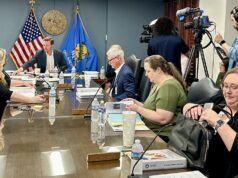
Following the absurd last week of the 2017 regular legislative session, Oklahoma made the front page of The Washington Post for gutting education funding to the point where 96 of the state’s 513 school districts will be reducing the school week to four days. The Post reviews the sorry story of how Oklahoma has cut education spending more than any other state, driving it down 14 percent since 2008. Only three states spend less per student than we do.
Moreover, the Post reports minimum teacher salaries have not been raised since 2008, putting us at 49th in the nation, and “teachers are leaving in droves for better-paying jobs.”
The Post recounts the evidence about how four-day school weeks hurt students. It explains, “Oklahoma stands out for the velocity with which districts have turned to a shorter school week,” as it notes that another 44 districts are considering a four-day week. It mentions our state’s hospitals and overcrowded prisons that also are suffering. The article didn’t get around to the most likely scenario that will make conditions much worse.
Soon afterward, Diane Ravitch, one of the nation’s most influential education writers, reposted the Post article. Washington Post columnist Valerie Strauss also weighed in on the exodus of teaching talent from Oklahoma. She reposted “All my ex’s teach in Texas,” by Shawn Sheehan, the 2016 Oklahoma Teacher of the Year and a National Teacher of the Year finalist. As he leaves for a job in Texas, Sheehan writes, “Teaching in Oklahoma is a dysfunctional relationship.”
Then, Governing Magazine featured the headline: “Nation’s Least-Funded Schools Get What They Pay for,” which starts its story on our education crisis: “Nowhere is the situation more dire than in Oklahoma.” Governing cites Moore Superintendent Robert Romines, who had to deal with the 2013 tornado, and explains, “Today, he is up against a subtler but deeply corrosive attack on his schools: death by a thousand spending cuts.”
What will the national papers headline if many or all of the legislative session’s last-minute tax increases are struck down by the Oklahoma Supreme Court, requiring more reductions?
Undoing the damage
Such publicity, of course, is not helpful in terms of the global marketplace. So, how do we undo this damage?
Sheehan tackles that issue, noting how conflicts within the education community undermine our political power. When an educator (or education funder) disagrees with others, he or she is likely to shut down discussion by saying, “It’s all about the kids,” thus accusing opponents with being preoccupied with “adult interests.”
Sheehan writes, “We won’t move the needle forward in education until teachers in this state acknowledge the plight of the teacher next door.”
I’d add two points:
- It’s really about all kids, everywhere, facing all sorts of challenges. It’s not just about the narrow portions of the brain that respond to bubble-in rewards and punishment in schools that don’t measure up to primitive metrics.
- Similarly, we won’t move the needle until teachers join with non-teachers and acknowledge the plight of our neighbors next door.
#oklaed’s woes reflect larger suffering
Teachers must remember that we are just some of the people targeted by the budget-cutting mania, and we’re not the most victimized. Our students are being hurt more than we are. And what about the other Oklahomans damaged by about $1.25 billion state appropriations cuts since FY 2009?
Yes, class sizes have grown to outrageous levels. But what about the 20 percent cuts over the last few years for the Oklahoma Department of Veterans Affairs? What about the “horrific” deaths of combat veterans in a system where one nurse distributes medicine to 50 people before each meal and three aides feed, clean and provide toilet assistance for 50 patients?
In high-poverty schools, especially, a minority of children with complicated mental health issues aggravates the workload. But let’s not forget the rest of the 70,000 Oklahomans with mental illness who faced cutbacks in services last year, and who will likely have to deal with more. Neither should we forget about the threats to 100,000 SoonerCare members who are aged, blind or have other disabilities. They represent only 20 percent of the Medicaid population but require almost half of its funding.
This is just the start
In other words, educators won’t improve our profession or our schools until we widen our perspective. It’s great that we are finally getting more political in order to help our kids, but that is just a start. We must ramp up our political efforts to provide equal opportunities and justice for all.





















